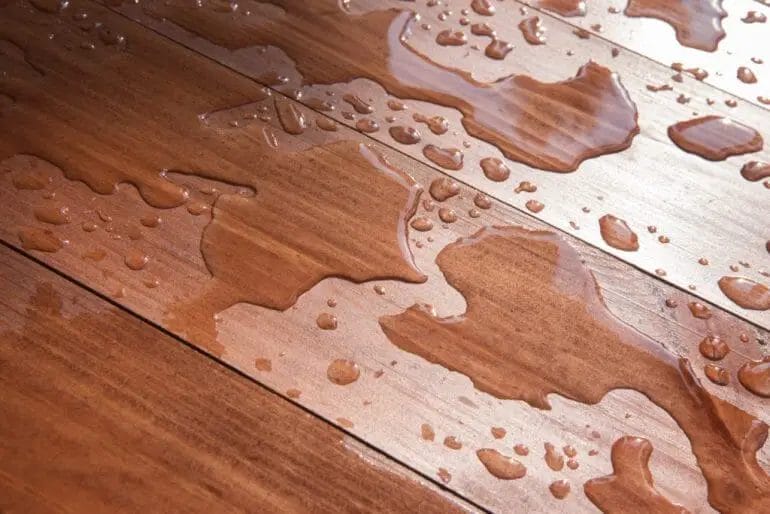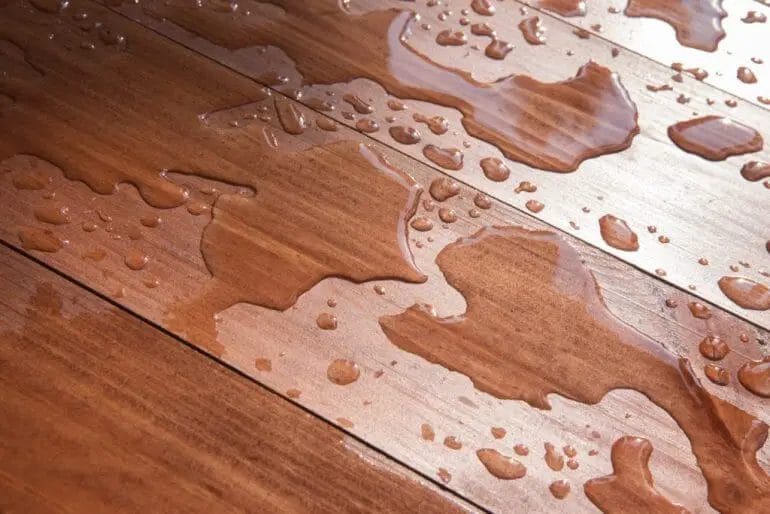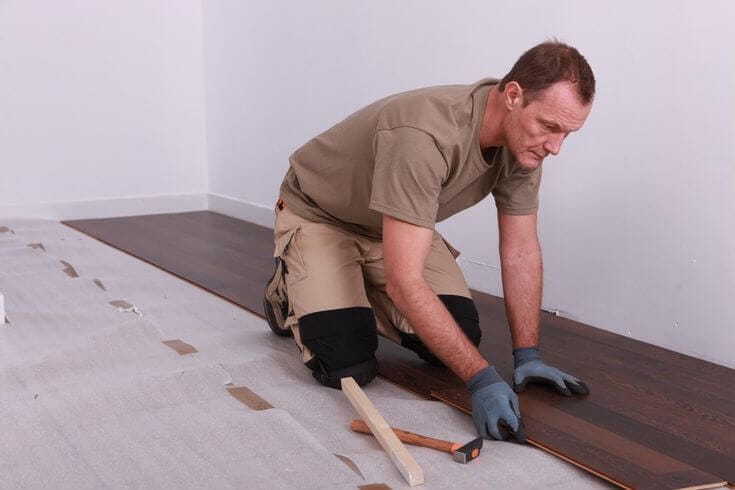If you have a buckled wood floor, don’t worry! There are solutions to fix this common issue.
Buckling can occur due to moisture or humidity, causing the wood to expand and buckle.

One way to fix a buckled wood floor is by identifying the source of moisture and addressing it.
Once the underlying cause is resolved, you can try using a dehumidifier or fans to dry out the affected area.
If the buckling persists, you may need to remove and replace the damaged boards.
Alternatively, hiring a professional for floor restoration can ensure a proper and long-lasting fix.
Remember, addressing the issue promptly will help prevent further damage and restore the beauty of your wood floor.

Signs of a Buckled Wood Floor
If you have a wood floor in your home, you know that it adds beauty and warmth to any space. However, wood floors are not immune to damage, and one common issue homeowners face is a buckled wood floor. Buckling occurs when the floorboards warp and lift away from the subfloor, creating unsightly and potentially hazardous conditions. In this section, we will discuss the signs of a buckled wood floor and what you can do if you encounter this problem.
1. Visible Changes in Floor Level
One of the first signs of a buckled wood floor is a visible change in the floor level. You may notice that certain areas of the floor appear raised or uneven. This can be particularly noticeable when walking across the floor, as you may feel a slight bounce or give in the affected areas.
2. Gaps Between Floorboards
Another telltale sign of a buckled wood floor is the presence of gaps between the floorboards. As the floorboards warp and lift, they may create spaces in between, leaving noticeable gaps. These gaps can not only ruin the aesthetic appeal of your floor but also pose a tripping hazard if left unaddressed.
3. Cupping or Crowning of Floorboards
When a wood floor buckles, it can result in cupping or crowning of the floorboards. Cupping occurs when the edges of the floorboards curl upwards, creating a concave shape. Crowning, on the other hand, refers to the center of the floorboards being higher than the edges, resulting in a convex shape. Both cupping and crowning are indications of moisture-related issues that can lead to buckling.
4. Changes in Floor Sound
If you notice any changes in the sound your wood floor makes when you walk on it, it could be a sign of buckling. A buckled floor may produce squeaking, creaking, or even cracking noises as the warped floorboards rub against each other or the subfloor. These unusual sounds should not be ignored and should prompt further inspection.
5. Moisture or Water Damage
Moisture or water damage is often the underlying cause of a buckled wood floor. Excessive humidity, leaks, spills, or inadequate subfloor ventilation can all contribute to the warping and lifting of floorboards. If you notice any signs of moisture damage, such as discoloration, mold growth, or a musty odor, it is essential to address the issue promptly to prevent further damage.
6. Difficulty Opening or Closing Doors
As a buckled wood floor expands and lifts, it can interfere with the operation of doors in the affected area. You may find that doors become difficult to open or close smoothly, or they may start to rub against the floor or door frames. This can be a frustrating and inconvenient issue that warrants attention.
7. Visual Inspection of Floorboards
If you suspect that your wood floor is buckled, it is essential to visually inspect the floorboards. Look for any signs of warping, lifting, or separation between the boards. Pay attention to changes in color or texture, as these can indicate moisture damage or other underlying issues. If you are uncertain about the condition of your floor, it may be helpful to consult a professional for a thorough assessment.
In summary, a buckled wood floor can be a frustrating and unsightly problem. By being aware of the signs of buckling, such as visible changes in floor level, gaps between floorboards, cupping or crowning of floorboards, changes in floor sound, moisture or water damage, difficulty opening or closing doors, and visually inspecting the floorboards, you can identify and address the issue promptly. Whether it requires simple maintenance or more extensive repairs, taking action can help restore your wood floor’s beauty and integrity.

Assessing the Damage: How Bad is It?
When facing a disaster or a crisis, one of the first questions that come to mind is, “How bad is it?” It is human nature to be curious about the extent of the damage and the impact it will have on our lives. Assessing the severity of the situation is crucial in determining the necessary actions to be taken and the resources required for recovery.
Damage assessment involves evaluating the physical, economic, and environmental consequences of a disaster. It provides a comprehensive understanding of the scope and scale of the damage, allowing authorities and organizations to allocate resources effectively for response and recovery efforts.
Physical Damage Assessment
The physical damage assessment focuses on evaluating the structural integrity of buildings, infrastructure, and other physical assets affected by the disaster. This assessment helps determine the extent of the destruction and the level of safety risks present in the affected areas.
Professionals such as engineers, architects, and construction experts conduct thorough inspections to identify and document the damage. They assess factors such as structural stability, damage to foundations, walls, roofs, and utilities. The information collected during these assessments is crucial for decision-making regarding necessary repairs, demolition, or replacement of affected structures.
Economic Damage Assessment
Economic damage assessment aims to quantify the financial impact of a disaster. This assessment takes into account direct losses, such as physical damage to assets, as well as indirect losses, such as business interruption and loss of productivity. Assessors consider factors such as property value, inventory loss, business interruption duration, and potential long-term economic implications.
By evaluating economic damages, authorities and insurance companies can determine the appropriate compensation for affected individuals and businesses. These assessments also aid in planning and prioritizing recovery efforts to minimize the long-term economic consequences of the disaster.
Environmental Damage Assessment
Assessing the environmental damage caused by a disaster is crucial for understanding the impact on ecosystems, natural resources, and public health. Environmental damage assessment focuses on evaluating the contamination of air, water, soil, and the potential loss of biodiversity.
Specialists in environmental sciences and ecology conduct studies to assess the extent of pollution, habitat loss, and the potential for long-term ecological damage. This information helps guide environmental restoration and conservation efforts, ensuring the sustainable recovery of affected areas.
Importance of Timely Damage Assessment
Timely damage assessment plays a crucial role in disaster management. The sooner the assessment is conducted, the quicker response and recovery efforts can be initiated. It allows for the effective allocation of resources, the identification of immediate needs, and the implementation of appropriate measures to mitigate further damage.
Furthermore, damage assessment provides valuable data for future disaster planning and risk reduction strategies. By analyzing the patterns of damage and vulnerabilities exposed during a disaster, authorities can implement measures to enhance resilience and minimize the impact of future events.
In summary, assessing the damage caused by a disaster is vital in understanding its severity and initiating the necessary response and recovery efforts. Physical, economic, and environmental damage assessments provide valuable insights that guide decision-making and resource allocation. By conducting these assessments in a timely manner, we can effectively mitigate the impact of disasters and work towards a more resilient future.

DIY Solutions to Fix a Buckled Wood Floor
If you have a wood floor in your home, you may encounter a common problem known as buckling. Buckling occurs when the wood floor starts to lift and warp, creating a noticeable bulge or hump. This can be caused by a variety of factors, such as moisture damage, improper installation, or changes in temperature and humidity. Fortunately, there are several DIY solutions you can try to fix a buckled wood floor before seeking professional help.
Identify the Cause of Buckling
The first step in fixing a buckled wood floor is to identify the underlying cause. This will help you determine the most effective solution. Here are some common causes of buckling:
- Moisture damage: Excessive moisture can cause the wood to expand and buckle. Check for any signs of water damage or leaks in the area.
- Improper installation: If the floor was not installed properly, it may buckle over time. Inspect the installation to see if any mistakes were made.
- Temperature and humidity changes: Fluctuations in temperature and humidity levels can cause the wood to expand and contract, leading to buckling. Determine if the buckling coincides with changes in the weather.
Fixing a Buckled Wood Floor
1. Identify and fix moisture issues
If moisture is the cause of the buckling, it’s important to address the underlying issue before attempting any repairs. Here are some steps you can take:
- Identify and fix any sources of moisture, such as leaks or excessive humidity.
- Dry out the affected area using fans or dehumidifiers.
- If the damage is severe, you may need to replace the damaged boards.
2. Release pressure on the buckled area
To alleviate the pressure on the buckled area, you can try the following steps:
- Remove any furniture or objects on the affected area.
- Carefully remove the baseboard or molding along the edge of the buckled floor using a pry bar.
- Using a circular saw or jigsaw, make a straight cut down the center of the buckled boards.
- Remove the damaged boards and clean the subfloor underneath.
3. Replace or repair the damaged boards
Depending on the severity of the damage, you can choose to repair or replace the buckled boards. Here are the steps for both options:
Repairing the boards:
- If the boards are salvageable, use a moisture meter to ensure they are dry enough for repair.
- Apply wood glue to the edges of the boards and carefully fit them back into place.
- Place heavy objects on top of the repaired area to apply pressure and allow the glue to dry.
- Once the glue is dry, sand down the repaired area to make it level with the rest of the floor.
- Finish the repaired area by staining and sealing it to match the surrounding floor.
Replacing the boards:
- If the boards are beyond repair, carefully remove them using a pry bar.
- Purchase replacement boards that match the type and color of the existing floor.
- Install the new boards, making sure to leave a small gap around the edges for expansion.
- Sand and finish the new boards to blend them with the rest of the floor.
Preventing Future Buckling
Once you have successfully fixed a buckled wood floor, it’s important to take preventative measures to avoid future issues. Here are some tips:
- Maintain consistent humidity levels in your home to minimize the expansion and contraction of the wood.
- Use area rugs or mats in high-moisture areas, such as kitchens and bathrooms.
- Ensure proper installation of the wood flooring, including acclimating the boards to the environment before installation.
- Address any leaks or water damage immediately to prevent moisture buildup.
In Summary
Fixing a buckled wood floor can be a DIY project if you have the right tools and know
Calling in the Professionals: Hiring a Wood Floor Repair Expert
Wooden floors bring warmth, elegance, and beauty to any space. However, over time, they may suffer from wear and tear, scratches, and other damages. When your wood floor is in need of repair, it is important to call in the professionals to ensure a job well done. In this section, we will explore why hiring a wood floor repair expert is the best course of action and how they can help bring your floor back to its former glory.
1. Expertise and Experience
Wood floor repair requires a certain level of expertise and experience to be done correctly. Professionals who specialize in wood floor repair have the knowledge and skills to assess the damage, identify the underlying issues, and determine the best repair method. They have a deep understanding of different wood types, finishes, and techniques, allowing them to provide the most effective solutions.
Furthermore, wood floor repair experts have experience working with a variety of floor problems, including water damage, scratches, gaps, and squeaks. They know how to handle each issue with precision and care, ensuring that your floor receives the necessary repairs without causing further damage.
2. Quality Results
When you hire a wood floor repair expert, you can expect top-quality results. These professionals have access to high-quality materials and tools, allowing them to deliver repairs that are durable and long-lasting. They will use the right products and techniques to seamlessly blend the repaired areas with the rest of the floor, creating a smooth and uniform finish.
Additionally, wood floor repair experts take pride in their work and strive for customer satisfaction. They will go the extra mile to ensure that the repaired floor looks as good as new. Their attention to detail and commitment to excellence will leave you with a floor that not only functions well but also enhances the aesthetic appeal of your space.
3. Time and Cost Efficiency
Attempting to repair a wood floor on your own can be time-consuming and costly, especially if you lack the necessary skills and knowledge. A DIY approach may lead to mistakes, which can further damage the floor and require additional repairs. On the other hand, hiring a professional will save you time and money in the long run.
Wood floor repair experts have the expertise to complete the job efficiently and accurately. They will assess the damage quickly, determine the most effective repair method, and complete the repairs in a timely manner. By leaving the job to the professionals, you can focus on other tasks while knowing that your floor is in capable hands.
4. Professional Advice and Maintenance Tips
When you hire a wood floor repair expert, you gain access to their wealth of knowledge regarding wood floor maintenance. These professionals can provide valuable advice and tips on how to care for your floor to prevent future damage. They may recommend specific cleaning products, techniques, or preventive measures to extend the lifespan of your floor and maintain its beauty.
Furthermore, wood floor repair experts can address any concerns or questions you may have about your floor. They can guide you on proper maintenance practices, such as how often to refinish or reseal the floor, how to handle spills and stains, and how to protect the floor from furniture scratches. Their expertise will help you make informed decisions about the care and maintenance of your wood floor.
5. Peace of Mind
One of the greatest benefits of hiring a wood floor repair expert is the peace of mind it brings. Knowing that your floor is in the hands of a professional eliminates stress and worry. You can trust that the repairs will be done correctly and that your floor will be restored to its former beauty.
Professional wood floor repair services often come with warranties or guarantees, giving you added assurance that any issues arising after the repair will be taken care of. This peace of mind is invaluable and allows you to enjoy your floor without any lingering concerns.
Summary
When it comes to repairing your wood floor, hiring a professional is the best decision you can make. Experts in wood floor repair bring the necessary expertise, experience, and knowledge to deliver high-quality results. They save you time and money while providing valuable advice and maintenance tips for your floor. With their help, you can enjoy a beautifully restored wood floor and the peace of mind that comes with it.
FAQs
How do I fix a buckled wood floor?
To fix a buckled wood floor, first determine the cause of the buckling. If it’s due to moisture, address the source of the moisture and allow the floor to dry out. Once dry, use a weight or clamp to flatten the buckled area. If the floor is severely damaged, it may need to be replaced.
Conclusion
In conclusion, if you have a buckled wood floor, it is important to address the issue promptly to avoid further damage and hazards. By following the correct steps, you can effectively fix the problem and restore the floor’s stability and appearance.
Remember to start by identifying the underlying cause of the buckling, whether it’s excessive moisture, improper installation, or structural issues. Then, carefully remove the damaged boards and address the root cause.
Afterwards, consult a professional for assistance if needed, and consider preventative measures such as maintaining proper humidity levels and monitoring any signs of potential issues.
With patience and proper care, you’ll be able to successfully repair your buckled wood floor and enjoy its beauty for years to come.